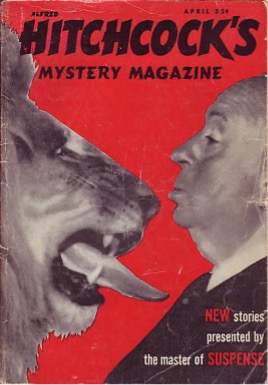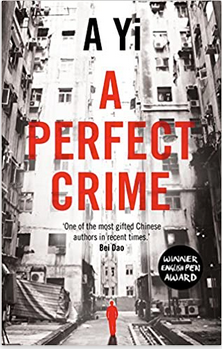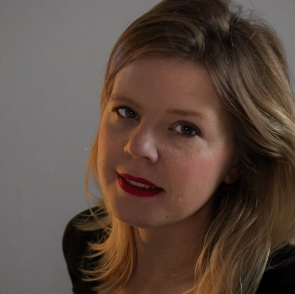“A Perfect Crime” by A Yi
How the mystery novel has changed over the past two centuries
Wilkie Collins wrote the first American mystery novel, The Woman in White, published in 1859. However, Edgar Allen Poe’s gruesome The Narrative of Arthur Gordon Pym of Nantucket preceded it by about twenty years. To the mystery reader, they bear interest to see how the genre has changed over the years.
A lot.
The period of the 1930s through the early 1960s was one of high mystery literature output, not only in novels but in all the short stories published in what were called dime magazines, because that’s all they cost – at first. There were dozens of them, most notably Alfred Hitchcock’s Mystery Magazine which began publication in 1956 and is still being published today.

Hitchcock never wrote a published short story or novel we know of, but man, the guy could edit and direct. I 2020 I watched “Rear Window” and read Cornell Woolrich’s story together, just to see his storyboarding. A genius, he was.
What’s different from then until now is how much more we see, or read, about the crime and its details. Watch Hitchcock’s “Psycho” and you’ll not see blood and gore. Bernard Herrmann’s musical score and your imagining what’s happening on the other side of that semi-transparent shower curtain do all the heavy lifting for you.
The great writers of those earlier mysteries were of the same mindset (remembering that earlier, both books and movies were often vetted for indecency; today of course, the lasciviousness of a film’s “Rating” is more a form of promotion than a deterrent). Books, of course, are no longer subject to being “Banned in Boston.”
So what is it we mortals enjoy so much about mysteries? The classic stuff: good guys vs. bad guys, nabbing a criminal, taking us out of our cozy existence for a few thrills. But it has to be a good mystery, doesn’t it? It seems as though many want to write in the genre but their narratives often don’t rise to the challenge. Not in the classical sense. So they go off the deep end with details of the crime. The more blood, the more hacking up, the more demented the killer (serial or otherwise) the better. But in the final analysis, the mystery plot hasn’t changed much in the last few centuries, perhaps only in the matter of the criminal’s escape. “Crime does not pay,” was consistently upheld, but over the past forty years that hasn’t been consistent.
Which brings me this week’s novel, The Perfect Crime by The Chinese author, A Yi. Most readers now know that there are perfect crimes committed and gotten away with quite often, giving rise to a mystery sub-genre dubbed “cold cases.” But perfect crimes are not often the book title; its veritably blatancy made me interested, and the fact that the author was Chinese cinched the purchase.

The author was a cop who wrote this novel a while back; it was translated for an English edition by the lovely and talented Swedish translator, Anna Holmwood. (a fascinating interview here; we often overlook the considerable difficulty a translator encounters.) Being close to your subject matter really works in most fictional subjects; several of the top mystery/thriller writers are former newspaper journalists, like Michael Connolly and John Sandford. We enjoy joining their fictional characters in the hunt and chase after the criminal. The more serious the crime, such as serial killers, cannibals, psychopaths and the like, the more today’s reader enjoys the story. That’s the biggest shift. What once only happened off-screen now is smeared all over the screen, the walls, the bodies, etc. Yet we as readers must have limits to how much we want to read about, or see; A Yi’s The Perfect Crime pushed right up against my limits.

In the case of A Perfect Crime, the story is told in the first person by the murderer, and its ending becomes readily observable since the murderer isn’t really trying to get away. He has no feelings, no remorse, not even much of a philosophy of life to warrant his crime. We want to think he’s like one of the boys in “West Side Story” singing about how misguided and misled they’ve been by society, but this eighteen-year-old boy kills without any purpose or reason except, perhaps, to say he’s angry with life and wants his to be over. Perhaps.
The book is short and in a Hemingwayesque style, clipped, simple, only briefly or occasionally descriptive. To my mind, it’s a poor comparison with Albert Camus’ The Stranger, which burbles and seethes with the social and the Meursault’s angst. A’s unnamed protagonist, when he’s able to analyze what he’s going to do or what he then did, seems to only account for the murder by saying he was bored. He wanted attention. It was something to do in order to blow off existential steam, or perhaps show how clever he could be in eluding capture. Something to show off, boast about, to the incompetent forces of law.
I can’t even begin to imagine what it would feel like to kill another human being, whether by intent or a seeming accident. Most mystery readers probably feel similarly, yet here we are, all of us, gulping down these books filled with mayhem and murder. I thought it might be interesting because it’s set in China, but no, that didn’t make it any different; it could happen the same way anywhere on the planet. It was well written and well translated. I liked the way the author titled the chapters so I always knew where things were headed. But otherwise, it was barely worth my time or my money.
At the closing of The Stranger, I was¾and even recall being¾consumed by all of Meursault’s tangled, estranged emotions and inner turmoil, his inability to understand everything going on inside of himself. And you know what? Yet as I write this, and the more I think about it, The Perfect Crime is in almost all respects a clone of The Stranger.




